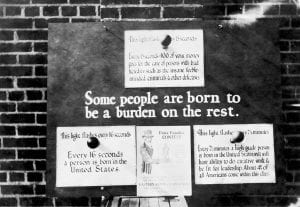
Eugenics exhibit at public fair. Display titled ‘Some people are born to be a burden on the rest’, with flashing lights indicating the rate at which money is spent to care for the mentally ill, the overall birth rate, and the rate at which ‘high grade’ people are born. At lower centre is a poster for the Fitter Families contest, judged using eugenics criteria. This display, dating from 1926, was part of the public education carried out by the American Eugenics Society (AES, founded 1923). Eugenics is the controversial practice of selectively improving the genetics of human populations. The AES was criticised for their racist assumptions and support of forced sterilizations.
Author: Grace Gordon
Interviewer: Kathleen Brett
The science of eugenics, or classifying and grouping people into the categories of genetically “inferior” and “superior,” thrived during the first two decades of the 19th century in America. Eugenics argued that the undesirable “inferiors” of America (immigrants, people of color, poor people, unmarried mothers, the disabled, the mentally ill, etc.) had to be identified and controlled so their inferior hereditary traits could not spread within America. Proponents of eugenics promoted their ideas to the American people as being necessary for the future wellbeing of the country. Due to the fear of “inferior” populations consuming the “superior” populations, eugenics was outwardly accepted within America and resulted in marriage laws enacted, immigration laws put in place, and state-sanctioned involuntary sterilization laws legalized. Ultimately, the American eugenics movement of the 1920s culminated with the decision of Buck v. Bell which affirmed the eugenic fear of human differences as something that needed to be controlled by American Law.
